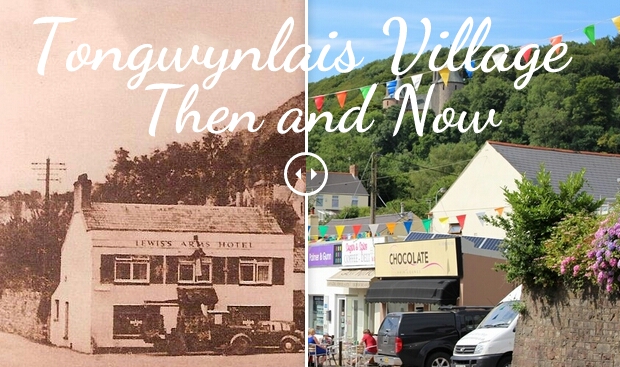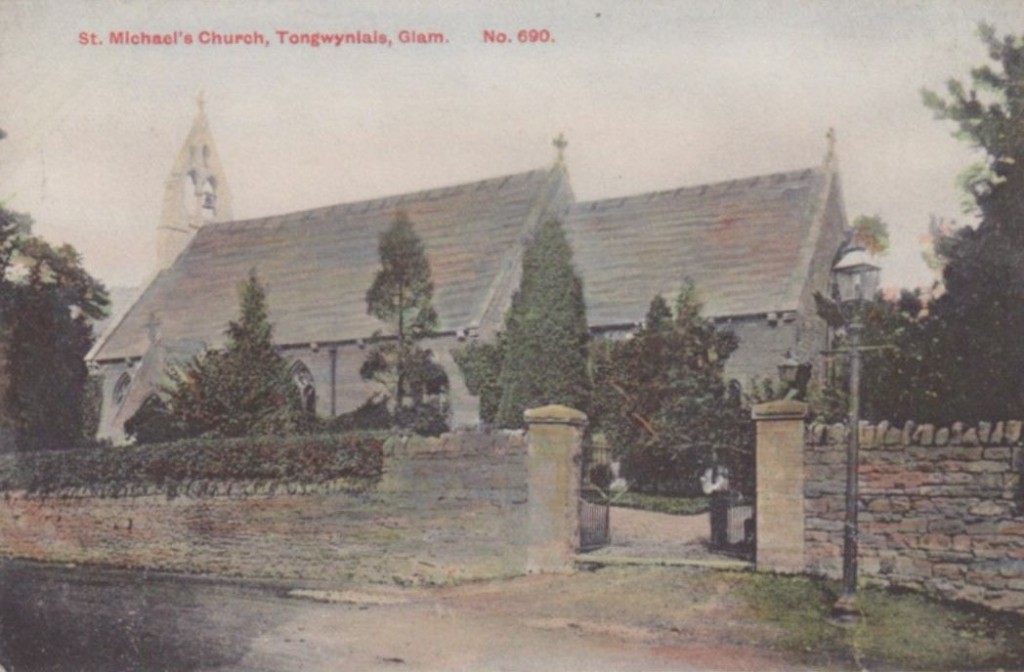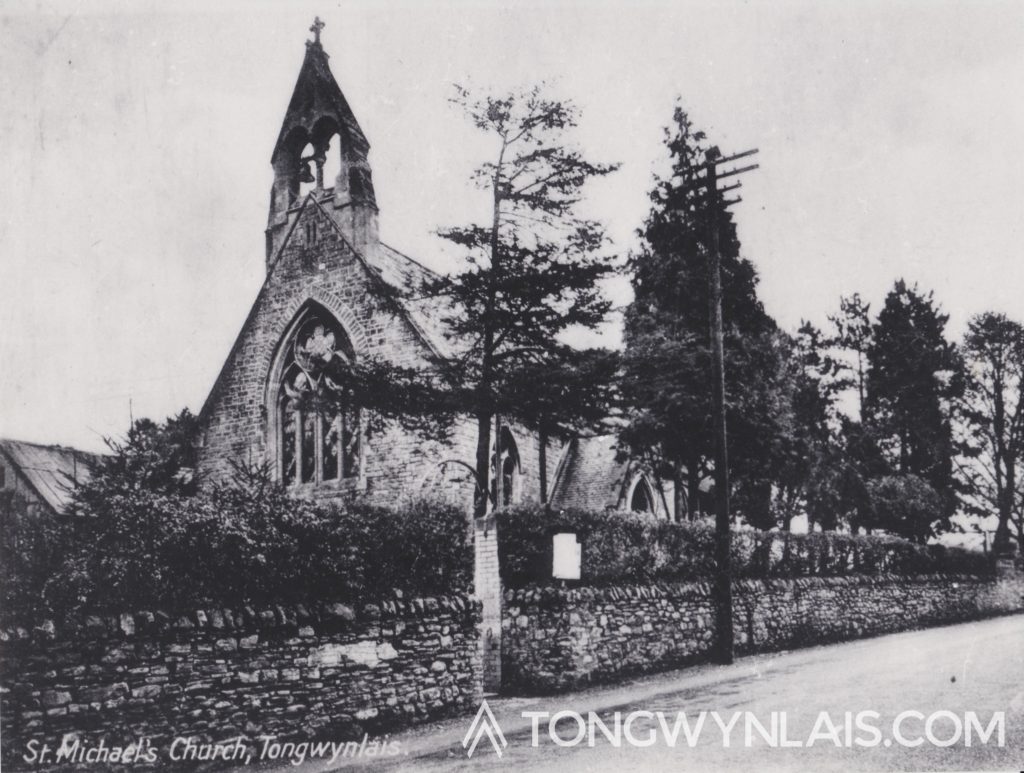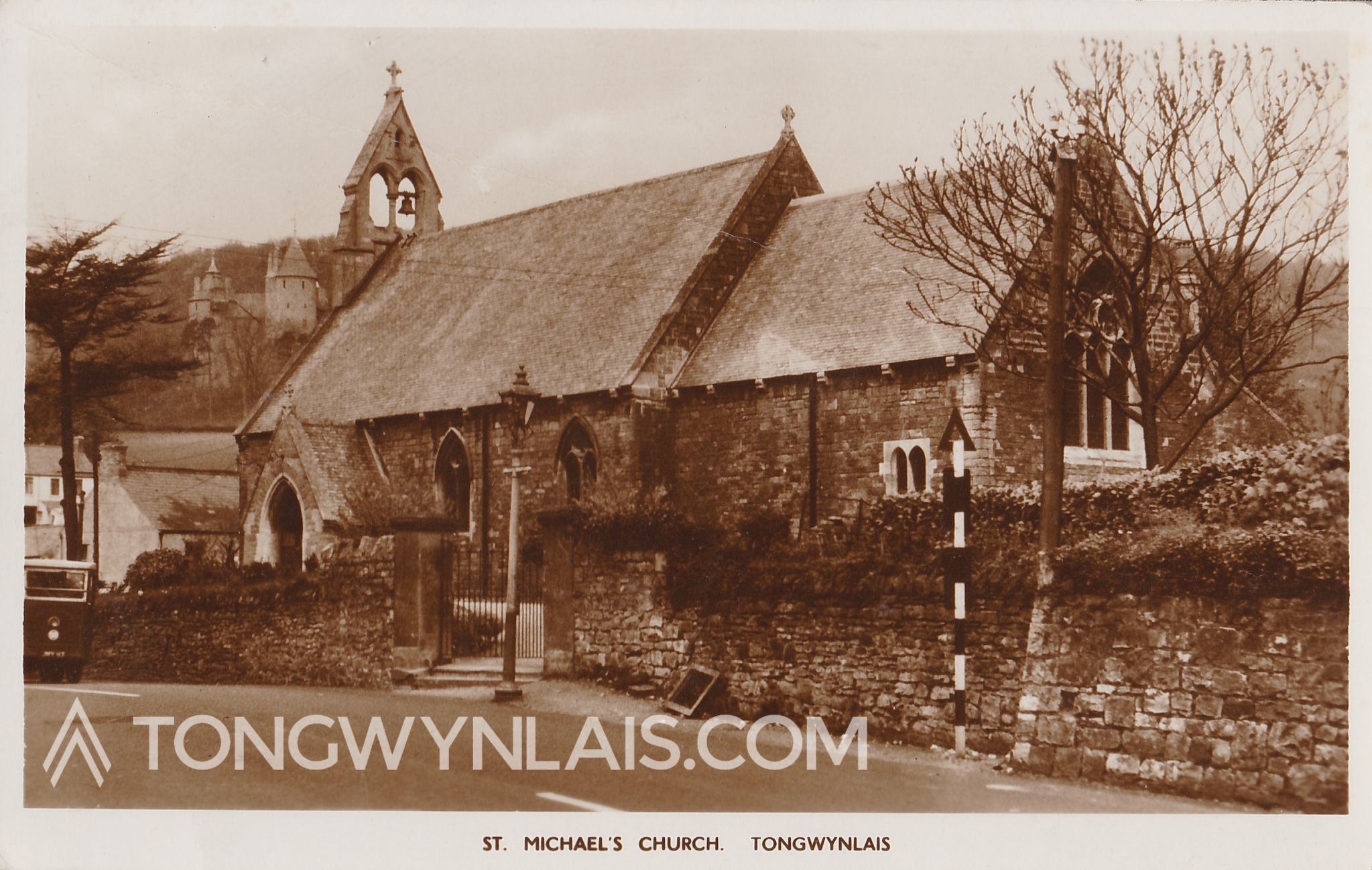This month we’re stepping back in time to 1875, when the foundation stone for St Michael’s Church was laid. The Western Mail reported on the ceremony, which took place on 10th June 1875. There’s lots of fascinating information and details about village life in the 19th century.
For more history and images of the village and Castell Coch, visit our dedicated history page.

On Thursday the foundation stone of the new church, which it is intended to erect at Tongwynlais, was laid with befitting ceremony. For a long time past it had been felt that the church accommodation in this increasing little village was quite inadequate to its requirements, and it was therefore resolved by several of the principal people in the neighbourhood that a great effort should be made to do away with any complaints that might, not unreasonably, exist in this respect. Active steps were accordingly taken, and soon, by means of a successful bazaar held at Cardiff, a grant from the Llandaff Diocesan Church Extension Society, and a hearty response to the appeal for assistance which the Church Committee had made, the funds were placed in such a position that further delay in commencing the building was unnecessary. So it was decided that the work should be pushed on at once, and, as it was impossible that any substantial progress could be effected until after the foundation stone had been laid, a gathering, having for its object the accomplishment of this necessary and interesting ceremony, took place at Tongwynlais on Thursday.

Related Post
Tongwynlais Village Then and Now
The village is one of the prettiest little places in the district, and it is astonishing, therefore, that situated as it is, only five or six miles from Cardiff, it should not have received that attention to which, on account of its charming situation and natural beauties, it is undoubtedly entitled. Nestling in a green valley, through which the Taff winds its course on towards Cardiff and the sea, and overlooked by the superbly wooded hill, from Castell Coch, at the summit of which a glorious view of the broad expanse which stretches from Newport to Cowbridge can be obtained, the village only requires to be lighted up by a fair amount of sunshine in order that it may become one of the most pleasant places conceivable for the performance of such a ceremony as the which it on Thursday witnessed. Sunshine to a man in his counting-house or his shop is generally very acceptable, but he is seldom found to indulge either in a paroxysm of joy when it is present, or of grief when a dark cloud takes the place of the clear blue, and the heavy raindrops begin pattering on the pavement outside his window. Sunshine, however, was to the people of Tongwynlais on Thursday a matter of very great consequence indeed, for was not the foundation stone of the new St. Michael’s Church to be laid; had not a silver trowel and a silver-mounted mallet come all the way from London; were not the said trowel and mallet to play a very prominent part in the day’s proceedings; and now, did not the rain appear likely to spoil everything? No doubt these were the questions passed from one villager to another as the rain, after coming down steadily all the morning, gained new strength about noon, and continued for a couple of hours to lash the roadways of the village with such fury that in short time the mud was ankle deep, and a walk of a dozen yards meant a wetting to the skin. About two o’clock, however, a gratifying change came over the weather, and the force of the rain suddenly ceasing, a gentle downpour succeeded. This soon ceased, and the dark clouds clearing as if by magic, revealed the good-natured face of the sun smiling down upon the place from a setting of clear sky as though he would say, “Cheer up I see I have gone quite far enough in the direction of lowering your spirits. Now, behold what I can do?” And the sun did do something too. He dried the roads that an hour before were nearly impassable, he permitted the villagers to venture forth from their dwellings, and to cluster in groups round the shop of Mr. Jeremy, where, in the most prominent place in the window lay the case which contained the trowel and the mallet, of which previous mention has been made, and he disposed of the very grave problems whether the ceremony must not either have to be put off or rendered a failure. There was no longer any fear on that score; the sun had completely answered the question, and the public answered it too, for now they began to appear in bright garments and Sunday suits, and to make their way towards the old church, from the belfrey of which came forth a sound which indicated that the hour was at hand, or to gather round the stone so soon to be laid in its bed, over which the silver trowel would be deftly passed. The party that had made for the church formed a procession, and marched to the site, on which, in the course of the next twelvemonth, will be raised a building of which Upper Whitchurch will have reason to be justly proud.

The stone, which was a handsome, well-proportioned block, was suspended by means of a crane, and close to the bed, into which at the proper moment it would sink, was a platform elevated a few inches above the adjoining ground. This space was reserved, and among those who were privileged to occupy it were the following :- Mrs. and the Misses Booker, Velindra; Mr., Mrs., and Mr, H. Lewis, jun., Greenmeadow; the Rev. J. J. Powell and Mrs. Powell, Tongwynlais; Mrs, Davies, the Vicarage, Whitchurch; the Rev. Mr. Parry and family, Tongwynlais; Mr. E, and Mrs. Griffiths; Rev. Horatio and Mrs. Thomas, Pentyrch; Rev. E. Jenkins, Whitchurch; Rev. G. W. Jones, St. Catharine’s. Pontypridd; Mr. Haddock, Whitchurch; Rev. G. B. Jones, Tenby; and Mr. Mardge, choirmaster. The crowd, which, by the time the platform was filled, was a very numerous one, having gathered round, the Rev. J. J. Powell, the curate in charge of Tongwynlais, arrayed in his surplice, stepped to the front, and commenced reading the order of service suitable for such an occasion. He spoke calmly and distinctly, and every sentence that he uttered could be heard without difficulty by all present. The responses were heartily joined in, and the singing of the choir reflected much credit upon Mr. Mardge, their instructor. Their rendering of the hymn commencing –
The Lord of Hosts, whose glory fills
The bounds of the eternal hills,
was especially good. After that portion of the services commencing, “Behold, I lay in Zion a chief corner-stone, elect, precious,” had been gone through, a bottle was placed upon the mortar in such a position that it would fit into a cavity in the foundation stone which hung immediately overhead. In this bottle were several coins of the present year’s date, and a parchment, on which were engrossed the following words :-
“In the faith of Jesus Christ this foundation stone is placed by Mabel Booker (eldest daughter of Thomas Williams Booker (of Velindra), and Henry Lewis, of Green Meadow, and dedicated to St. Michael, in the name of God the Father, God the Son, and God the Holy Ghost, June 10th, 1875.”
Miss Booker then touched the mortar with the trowel, and a signal being given, the stone was lowered into its bed. Mr, Lewis, jun., Greenmeadow, next struck the stone with the mallet, and the ceremony was declared to be complete.
The trowel was of solid silver, exquisitely designed, with an ivory handle, and on the face of it, as well as on the mallet, which was of boxwood, with a circular silver plate inserted in the head, was the following inscription (the blank here left being filled with the name of Miss Booker or Mr. Lewis) :- “Presented to —–, on the laying down of the Foundation Stone. St. Michael’s Church, Tongwynlals, Whitchurch.”
The trowel case was of brown morocco, inlaid with gilt, and lined with violet satin and velvet. The trowel and mallet having been handed about on the platform for inspection, were presented to Miss Booker and Mr. Lewis by the Rev. J. J. Powell. After the ceremony had been brought to a conclusion, the Rev. Horatio Thomas made a few remarks, in the course of which he referred to the sermon by Dean Swift from the text, “He that giveth unto the poor lendeth to the Lord.” He knew nowhere, he said, that was so much in want of a place of worship in connection with the Established Church as that place, which seemed to have been overlooked for a number of years, until certain kindly disposed people took the matter in hand. He did not know what the result might be, but they might rest assured that it would not be an appeal in vain. The church was to be built almost exclusively for the good of the inhabitants of the place, who were, as they knew, not of the wealthy classes. He could only say that he hoped the foundation stone which had been laid that day would be the means of glorifying God, and of promoting the eternal spiritual welfare of the neighbourhood. He thought they could not do better than offer their sincere thanks to those who had taken such a warm interest in the building. The reverend gentleman having concluded his observations, the assembly dispersed. A luncheon was afterwards served to the clergy and others by Mr. Whitney, of the Lewis’s Arms Hotel, Tongwynlais.

The following details of the contemplated new church may be of interest :- It will be built from the plans of Mr. John Prichard, diocesan architect, and the work will be carried out by Mr. Franklin, contractor, of Splotlands, Cardiff, who has had great experience in the building of ecclesiastical structures. The church will be in the early English style, and will consist of a nave, a chancel, a south porch, and a vestry. The belfry will be at the west end, and there will be large east and west windows. The walling will be of native stone, quarried on the Greenmeadow estate, and given by Mr. Lewis, and the dressings will be of box ground stone. The roof is to be open bordered work, covered with small green Penmoyle tiles, and the aisles and chancel will be floored with tiles from the works of Messrs. Godwin and Co., of Lugwardine, near Hereford. The pulpit, stalls, pews, &c., will be of pitched pine, and the building is designed to comfortably seat about 300 persons. The sand used in the building will be given by Mr. Booker. The site, which is central, is the very best that could be selected, and was chosen by Mrs. Lewis. The ground will not be all built upon, but there will be a very pleasant approach, which, when planted with grass and railed in, will have from the road an exceedingly good effect. The total cost will be about £2,000, of which upwards of £1,300 has been already subscribed*. We may state, in conclusion, that Mr. T. W. Booker was absent through illness, and Mr. Prichard, the architect, was not present, having an important engagement in England.
*The Bank of England’s Inflation Calculator works out that goods and services valued at £2,000 in 1875 would cost £226,693.88 in 2018.



How very interesting, I really enjoyed reading that – I wonder where the trowel and mallet are now, if they are still about and if the bottle with the coins in is still in the foundation stone. I love the way this is written, they don’t write articles like this anymore. Thanks Jack for posting.